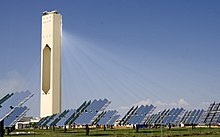 Scientists at the University of Michigan have discovered a new effect from an old property of light, which they say could lead to an "optical battery" that converts sunlight to electricity at a fraction of the cost of today's photovoltaic cells.
Scientists at the University of Michigan have discovered a new effect from an old property of light, which they say could lead to an "optical battery" that converts sunlight to electricity at a fraction of the cost of today's photovoltaic cells.
Light has electric and magnetic qualities. Scientists had long thought, however, that the effects of light's magnetic field were so weak as to be irrelevant.
No so, says Stephen Rand, a professor of physics. Along with doctoral student William Fisher, he persisted in probing the long-ignored weak magnetic field that light produces when traveling through a nonconductive material, such as glass.
The breakthrough – unveiled Friday in a scientific paper in the Journal of Applied Physics – shows that if light is intense enough, it can, when traveling through nonconductive material, generate voltage from magnetic effects 100 million times stronger than earlier expected. Such magnetic effects produce a strong electric field that can be harnessed for electric power production, Dr. Rand and Mr. Fisher say.
“This could lead to a new kind of solar cell without semiconductors and without absorption to produce charge separation,” Rand said in a statement. “In solar cells, the light goes into a material, gets absorbed and creates heat. Here, we expect to have a very low heat load. Instead of the light being absorbed, energy is stored in the magnetic moment.”
He continues, “Intense magnetization can be induced by intense light and then it is ultimately capable of providing a capacitive power source.”





 The Trump administration has said it is immediately pausing all leases for offshore wind farms already...
The Trump administration has said it is immediately pausing all leases for offshore wind farms already... International Atomic Energy Agency (IAEA) Director General Rafael Grossi said on Friday that an IAEA team...
International Atomic Energy Agency (IAEA) Director General Rafael Grossi said on Friday that an IAEA team... Two fossil-fuel billionaires with close ties to Donald Trump bought millions of shares in the company...
Two fossil-fuel billionaires with close ties to Donald Trump bought millions of shares in the company... The Trump administration on Thursday announced new oil and gas drilling off California’s and Florida’s coasts,...
The Trump administration on Thursday announced new oil and gas drilling off California’s and Florida’s coasts,...






























